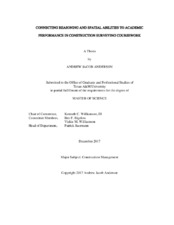| dc.description.abstract | Cognitive tests measuring reasoning ability have been well established as a means of predicting academic success in STEM (Science, Technology, Engineering, and Math) coursework. Cognitive tests measuring spatial ability have garnered recent attention and have also been established as predictors of academic success in the “traditional sciences” (i.e., Chemistry, Biology, Physics, etc.). Instructors may use these cognitive tests as a means of predicting student achievement or adapting instruction. This study examined the relationship between scores on the Test of Logical Thinking (TOLT); a spatial test battery consisting of the Paper Folding Test (PFT), Hidden Patterns Test (HPT), Mental Rotations Test (MRT), and Purdue Visualization of Rotations Test (ROT); and multiple academic achievement measures (Lab Points, View Points, Exam Points, and Total Grade Points) in an upper-level undergraduate construction surveying course.
The TOLT and the spatial test battery were administered to 277 construction science students. The scores on the TOLT and scores on all spatial battery tests were found to be significantly correlated. Additionally, significant differences utilizing an Analysis of Variance (ANOVA) were found between the TOLT groups and exam points. Further, significant differences were discovered, using an ANOVA, between all the spatial ability test battery groups and achievement points in exams, and a significant difference was also discovered between the ROT groups and view points. Based on these findings, educators and researchers in construction science would benefit by using these cognitive tests to assess student reasoning and spatial abilities. These tools would assist them in better understanding their students’ logical thinking and spatial visualization skills, which should encourage instructors to modify instructional strategies and curriculum design to match or enhance their students’ cognitive abilities. | en |


